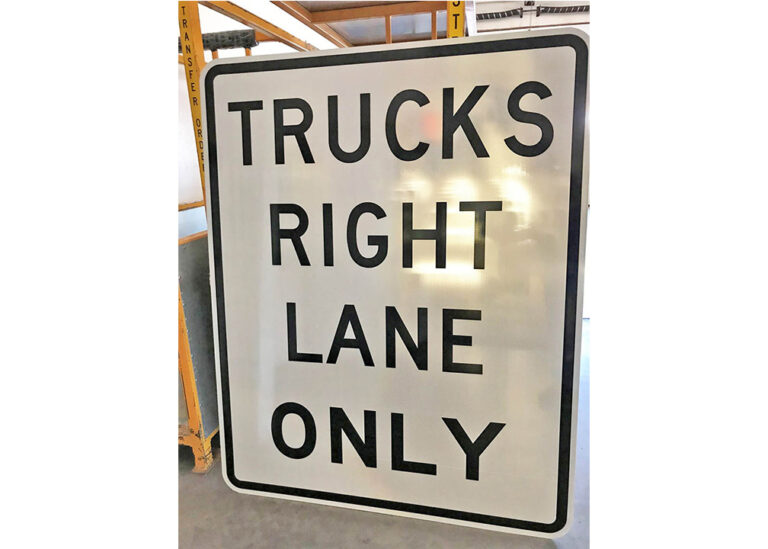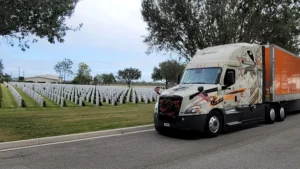PHOENIX — To promote safety on a 20-mile segment of Interstate 10 between Phoenix and Casa Grande, the Arizona Department of Transportation (ADOT), in collaboration with the Department of Public Safety (DPS), said it is installing signage that will note the new, partial restriction of heavy vehicle truck traffic on this busy section of highway.
Truck traffic will be restricted to the right lane only.
The signs are an interim safety measure along the final two-lane stretch of I-10 between Phoenix and Tucson that has yet to be widened to three lanes in each direction.
“This segment has safety concerns due to heavy traffic flow and truck traffic,” the news release stated. “The right-lane restriction for heavy vehicle truck traffic is intended to help reduce crashes, along with the resulting delays and closures due to these incidents.”
Based on data for the area where the signs are being posted, heavy vehicles were involved in about 20 percent of crashes and 15 percent of rear-end and sideswipe crashes, according to ADOT.
The signs are intended to be in place until an improvement project kicks off to widen this segment of I-10.
The first step is expected in 2023 with the replacement of bridges that carry traffic over the Gila River, following required environmental review and clearance. Also, ADOT is working closely with the Gila River Indian Community and the Maricopa Association of Governments to secure federal funding, to add to committed state funding, for work that could be completed as early as 2026.
The signs restricting heavy vehicle truck traffic to the right lane only are similar to those that ADOT has employed elsewhere, including Interstate 17 north of Black Canyon City. Sign installation began Monday and is expected to continue through this week.
ADOT has worked to coordinate the interim safety measure with DPS and the Arizona Trucking Association.
ADOT officials said they will closely monitor traffic operations now that the signs and right-lane restrictions are in place.
For more information about plans to widen I-10 between Phoenix and Casa Grande, visit http://i10wildhorsepasscorridor.com/.
The Trucker News Staff produces engaging content for not only TheTrucker.com, but also The Trucker Newspaper, which has been serving the trucking industry for more than 30 years. With a focus on drivers, the Trucker News Staff aims to provide relevant, objective content pertaining to the trucking segment of the transportation industry. The Trucker News Staff is based in Little Rock, Arkansas.
















I’ve just read a few articles about the lane restrictions for heavy vehicles on I-10.
I had no idea the new rule had been imposed on truck drivers until June 20th. I was sited for violating the new rule while passing a truck doing 15 mph under the speed limit. Apparently there are no exceptions to this ridiculous new rule, although I had been passed by several other trucks myself.
One of he things that bothers me is the reason given for this new source of revenue rule.
“According to data from ADOT, heavy vehicles were involved in approximately 20% of crashes and 15% of rear-end and sideswipe crashes in the area the signs are being posted.”
That means 80% of the accidents are not heavy vehicles!
85% of rear-end and sideswipe crashes are not heavy vehicles!
So why single out trucks? Why not impose that restriction on cars?
It is hard to imagine the driver of a commercial motor vehicle, who drives all 48 states and Canada, taking time off to come to court in Casa Grande to defend himself from a $235.00 fine. The cost to defend myself is far greater than the fine, however, not defending myself against such an outrageously unethical rule has a much greater cost. Because as a commercial truck driver, this type of situation can cost us our ability to drive, we can loose our livelihood.
Using the left lane for 2 minutes to pass a vehicle going 15 mph under the speed limit cost a driver $235.00? It appears, since there is no other true reason, this rule was implemented only to help fund the road project.
This rule has nothing to do with safety, since it’s not heavy vehicles who cause most crashes on I-10, this is all about money and the easiest targets are truck drivers.
ADOT spokesperson Garin Groff says ADOT “will be monitoring the situation if there are any unforeseen consequences. And will make adjustments if needed.
Is being unable to pass slow moving vehicles something they can adjust?
I haven’t seen one cop enforce this on my long commute home. Truckers still regularly use the left lane to pass. Thanks for cutting me off and slowing me down because you wanted to drive 76 mph and the truck going 74 mph in front of you is way too slow. You slow everyone in the left lane down. I can’t wait for self driving trucks. At least they’ll be programmed to obey the law.